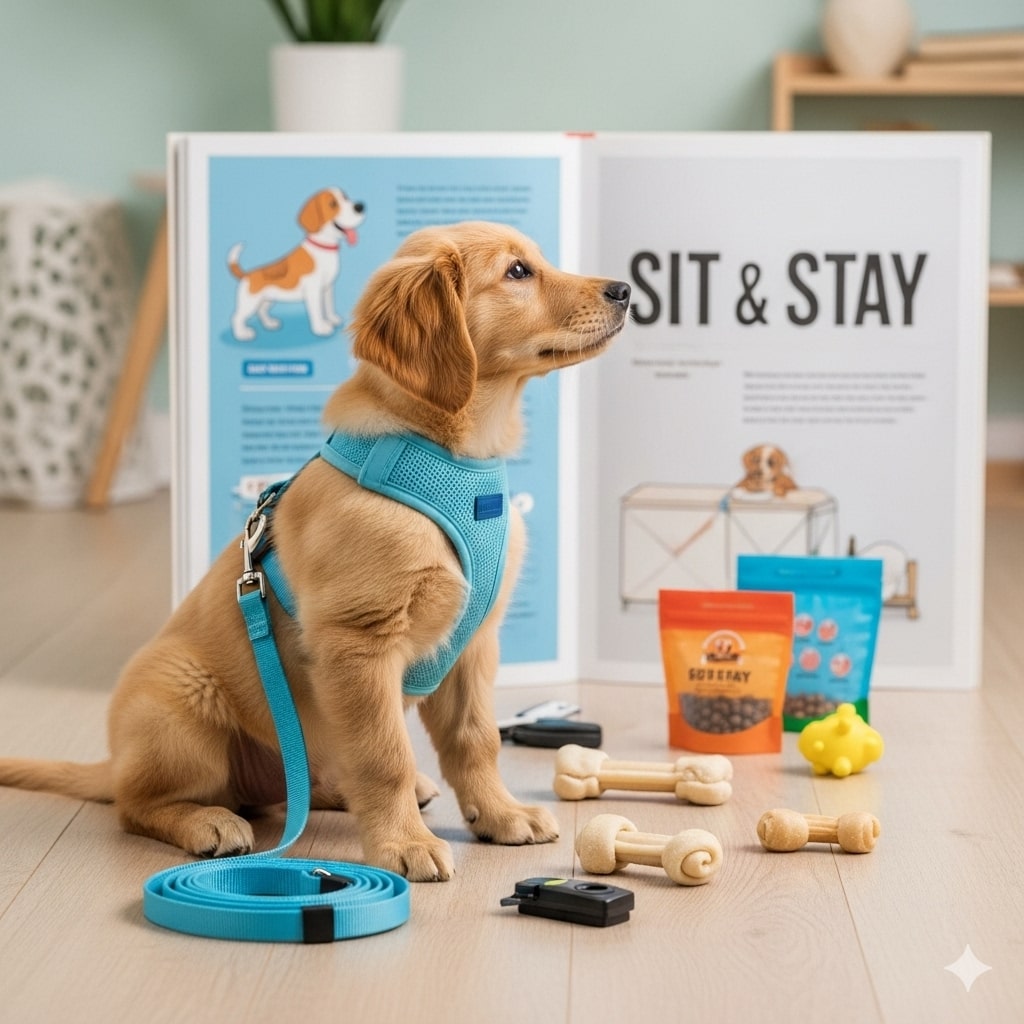“Discover the Ideal Age to Train Your Puppy with Step-by-Step Tips for Effective Puppy Training”
The best age to train a puppy is generally between 8 and 16 weeks old, as they are most receptive to learning and forming habits during this period. Early socialization and basic obedience training can prevent future behavioral problems.
However, training should continue throughout a dog’s life, with advanced commands and tricks being introduced as they mature. Consistency, patience, and positive reinforcement are key to a successful training journey.
Bringing home a new puppy is one of life’s greatest joys, but with joy comes responsibility. Puppies are playful, curious, and eager to learn. As a pet parent, one of the most important questions you’ll face is: “When should I start training my puppy?”
The truth is, puppy training begins much earlier than most people think. Whether it’s learning basic commands like sit and stay, socializing with other pets, or housebreaking, starting at the right time sets the foundation for lifelong good behavior.
Discover More: Best Affordable Pet Insurance for Puppies in the USA 2025

In this comprehensive guide, we’ll explore:
- The best age to begin puppy training
- Step-by-step training timelines by weeks and months
- Methods that actually work (positive reinforcement, crate training, clicker training)
- Common mistakes to avoid
- Expert-backed advice to raise a well-adjusted, confident dog
By the end, you’ll have a clear roadmap to ensure your puppy grows into a happy, obedient, and well-mannered companion.
Discover More: Puppy Crate Training for Beginners: The Ultimate Guide
Chapter 1: Understanding Puppy Development
Before diving into training timelines, it’s crucial to understand a puppy’s growth stages. Just like human babies, puppies go through phases of development, both physically and mentally. Training success depends heavily on these stages.
1.1 Neonatal Stage (0–2 Weeks)
- Puppies are blind, deaf, and completely dependent on their mother.
- No formal training happens at this stage.
- Gentle handling by breeders helps puppies get used to human touch.
1.2 Transitional Stage (2–4 Weeks)
- Eyes and ears begin to open.
- Puppies start walking, wagging tails, and exploring.
- Early exposure to gentle sounds and light handling helps socialization.
1.3 Socialization Stage (3–14 Weeks)
- The most critical stage for training.
- Puppies are highly impressionable.
- Exposure to new environments, people, and other pets builds confidence.
- Basic commands and house training can begin here.
1.4 Juvenile Stage (3–6 Months)
- Rapid growth and boundless energy.
- Perfect time for structured training.
- Puppies can start learning more complex commands and leash manners.
1.5 Adolescence (6–18 Months)
- Comparable to the teenage phase.
- Puppies test boundaries and may become stubborn.
- Consistency and patience are vital.
Chapter 2: When to Start Training a Puppy
So, what’s the ideal age to start training?
- Basic training (housebreaking, name recognition, simple commands) should start as early as 7–8 weeks old.
- Formal obedience training can begin around 12 weeks, once the puppy has received some vaccinations and can safely socialize outside.
2.1 Why Early Training Matters
- Prevents bad habits from forming.
- Builds trust and strengthens the human-animal bond.
- Helps puppies grow into well-mannered adult dogs.
2.2 Common Myth: “Wait until the puppy is older”
This misconception leads to stubborn, hard-to-train adult dogs. Starting early ensures puppies adapt to routines naturally.
Chapter 3: Puppy Training Timeline
Here’s a week-by-week guide on when and how to train your puppy.
3.1 7–8 Weeks Old
- Start with name recognition and housebreaking.
- Teach simple commands: sit, come.
- Begin crate training.
3.2 8–10 Weeks Old
- Introduce socialization with people and gentle dogs.
- Continue potty training with consistent schedules.
- Use positive reinforcement (treats, praise).
3.3 10–12 Weeks Old
- Practice short leash walks in safe areas.
- Teach stay and down.
- Encourage calm behavior around distractions.
3.4 3–4 Months Old
- Puppies can attend puppy training classes.
- Learn impulse control (leave it, drop it).
- Practice recall in different environments.
3.5 4–6 Months Old
- Focus on bite inhibition (gentle play).
- Extend training sessions to 10–15 minutes.
- Begin teaching heel and polite greetings.
3.6 6–12 Months Old
- Strengthen all learned commands.
- Train around distractions like parks or busy streets.
- Introduce agility or advanced obedience training.
Chapter 4: Training Methods
Choosing the right training method is key. Here are the most effective techniques.
4.1 Positive Reinforcement
- Reward-based training using treats, toys, or praise.
- Builds trust and keeps learning fun.
- Scientifically proven as the most effective approach.
4.2 Clicker Training
- Uses a “click” sound to mark correct behavior, followed by a reward.
- Enhances communication and speeds up learning.
4.3 Crate Training
- Helps with housebreaking and creating a safe space.
- Puppies learn to see their crate as a cozy den, not a punishment.
4.4 Leash Training
- Start with short, positive sessions indoors.
- Gradually introduce outdoor walks.
- Teach calm walking without pulling.
Chapter 5: Socialization – The Key to Success
Training isn’t only about commands; it’s also about socialization.
5.1 Why Socialization Matters
- Prevents fear and aggression later in life.
- Helps puppies adapt to different environments.
- Builds confidence.
5.2 How to Socialize Your Puppy
- Introduce new people daily.
- Expose to safe environments (parks, car rides).
- Familiarize with sounds (vacuum, traffic, doorbells).
- Controlled playdates with other dogs.
Chapter 6: Common Training Mistakes to Avoid
Many new pet owners make mistakes that can delay progress.
- Inconsistency: Different family members using different commands.
- Punishment-based training: Creates fear, not respect.
- Training too long: Puppies have short attention spans.
- Skipping socialization: Leads to fearful, aggressive dogs.
Chapter 7: Tools for Puppy Training
7.1 Must-Have Training Tools
- Treat pouch
- Clicker
- Comfortable leash and harness
- Crate
- Chew toys
7.2 Optional But Helpful Tools
- Training pads for housebreaking
- Puzzle toys for mental stimulation
- Long training leash for recall practice
Chapter 8: Frequently Asked Questions (FAQ)
Q1: Can you start training a puppy at 6 weeks?
Yes, but only with gentle basics like name recognition and potty training.
Q2: Is 12 weeks too late to start training?
Not at all. It’s still the perfect age for structured training.
Q3: How long should training sessions be?
5–10 minutes for young puppies, gradually increasing as they grow.
Q4: Should you hire a professional trainer?
Professional trainers are helpful for first-time owners or specific behavior problems.
Chapter 9: Expert Tips for Puppy Training Success
- Keep training sessions short and fun.
- Use consistent cues and body language.
- Always end on a positive note.
- Be patient – progress takes time.
- Remember: every puppy learns at their own pace.
Learn More Veterinary & Health Sources
- American Kennel Club – Puppy Training Tips
- ASPCA – Dog Training & Behavior
- PetMD – Puppy Development & Training
Conclusion
Training a puppy is one of the most rewarding parts of dog ownership. By starting early—ideally at 7–8 weeks old—you set the stage for lifelong good behavior, obedience, and trust.
With consistent training, positive reinforcement, and plenty of socialization, your puppy will grow into a confident, well-mannered dog. Remember, patience and love are your greatest training tools.
So, don’t wait until bad habits form. Begin today, and enjoy the lifelong bond that comes with a well-trained puppy.
